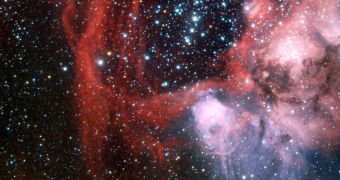While analyzing the star cluster NGC 1929, inside the Large Magellanic Cloud (LMC), astronomers discovered a structure that they refer to as a massive cosmic superbubble. Such formations are fairly rare, as they need a very specific set of conditions in order to develop.
This particular one is produced by a large number of shock waves produced by past supernova explosions, and also by intense solar winds emanating from a number of blue stars in the nursery.
The nebula where the superbubble is located surrounds NGC 1929. Stars within the cluster are the main factors that contribute to shaping the massive, spherical structure. The object was observed using the Very Large Telescope (VLT).
The interferometry telescope is based in Chile, and is managed by the European Southern Observatory (ESO). It is very well suited for conducting investigations of large objects near and far. Resolving the superbubble in the LMC, a dwarf galaxy orbiting the Milky Way, was no problem for the facility.
One of the most impressive things about the Large Magellanic Cloud is the fact that it contains vast volumes of molecular hydrogen gas – organized in large clouds – and that it creates new, blue stars at a frantic pace.
LHA 120–N 44 (N 44 for short) is one of these nebulae. Stars inside the stellar cluster it contains release huge amounts of particles as stellar winds. These particles then go on to make the nebula glow.
Ultraviolet radiation from these stars cause the superbubble to shine bright, experts say. The object was found to extend between 250 and 325 light-years away from the cluster. The distance between the Sun and the nearest star outside our solar system is 4 light years.
“Although the superbubble is shaped by destructive forces, new stars are forming around the edges where the gas is being compressed. Like recycling on a cosmic scale, this next generation of stars will breathe fresh life into NGC 1929,” an ESO press release states.
Experts at the Observatory say that stellar winds began carving out the bubble at first. Later on, as massive stars within the cluster reached the end of their burning cycle, they exploded as supernovae. The shock waves that were produced at that time carved the bubble further, and also made it glow.
Astronomers now plan to continue analyzing the LMC, which contains a large number of well-known objects. Studying nebula and stellar nurseries inside this dwarf galaxy could shed more light on how new stars form, and also on how galaxies evolve.

 14 DAY TRIAL //
14 DAY TRIAL //